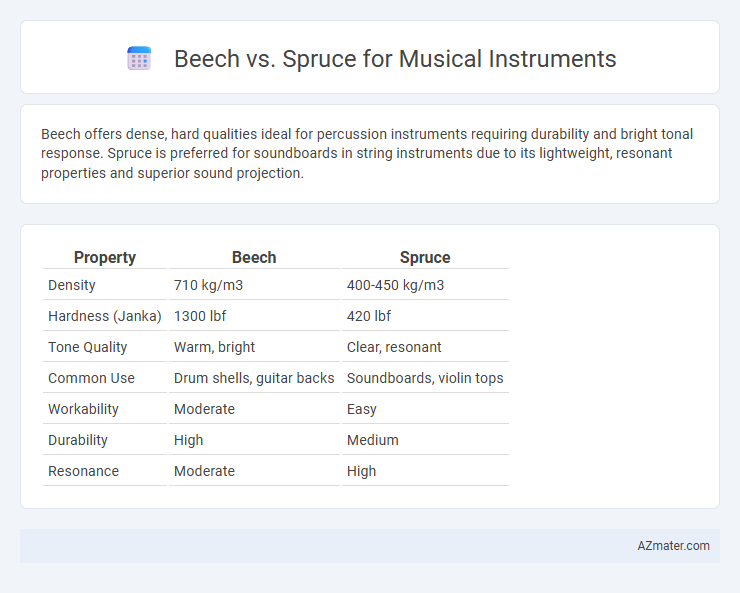Beech offers dense, hard qualities ideal for percussion instruments requiring durability and bright tonal response. Spruce is preferred for soundboards in string instruments due to its lightweight, resonant properties and superior sound projection.
Table of Comparison
| Property | Beech | Spruce |
|---|---|---|
| Density | 710 kg/m3 | 400-450 kg/m3 |
| Hardness (Janka) | 1300 lbf | 420 lbf |
| Tone Quality | Warm, bright | Clear, resonant |
| Common Use | Drum shells, guitar backs | Soundboards, violin tops |
| Workability | Moderate | Easy |
| Durability | High | Medium |
| Resonance | Moderate | High |
Introduction: Beech vs Spruce in Musical Instrument Crafting
Beech offers a dense, hard texture that provides durability and a balanced tone ideal for electric guitar bodies and drum shells, while spruce is prized for its lightweight, resonant qualities that enhance sound projection in acoustic instruments like guitars, violins, and pianos. Spruce's superior strength-to-weight ratio makes it a preferred choice for soundboards, delivering clarity and dynamic range, whereas beech contributes robustness and a warm midrange suitable for instrument components requiring structural stability. The selection between beech and spruce hinges on the desired tonal characteristics and functional requirements of the musical instrument.
Wood Grain and Structure: Beech Compared to Spruce
Beech wood features a tight, straight grain with a fine, uniform texture that provides durability and a smooth finish for musical instruments, favoring instruments requiring sturdy construction. Spruce, characterized by a more pronounced, straight grain with a slightly softer texture, is prized for its excellent resonance and flexibility, making it ideal for soundboards and instruments needing superior tonal qualities. The denser grain of Beech contributes to its robust structural integrity, while Spruce's lighter grain structure enhances vibration and sound projection.
Tonal Qualities: How Beech and Spruce Sound
Beech wood offers a warm, balanced tone with moderate resonance, making it suitable for instruments requiring a clear yet soft sound. Spruce is prized for its bright, crisp tonal quality and strong projection, often favored in soundboards of guitars, violins, and pianos. The denser grain of beech contributes to its softer sustain, while spruce's lighter, more flexible fibers enhance responsiveness and dynamic range.
Workability: Crafting Instruments with Beech and Spruce
Spruce is highly prized for its excellent workability in crafting musical instruments due to its lightweight, straight grain, and soft texture, which allow for precise carving and shaping, crucial for soundboard construction. Beech offers moderate workability with a harder, denser composition, making it more challenging to carve but beneficial for instrument parts requiring durability and strength, such as necks or structural supports. The choice between spruce and beech depends on the specific instrument component, with spruce favored for resonance and tonal clarity and beech selected where robustness and longevity are essential.
Durability and Longevity in Instruments
Beech offers excellent durability with its dense and hard grain, making it resistant to dents and wear in musical instruments like drums and electric guitar bodies. Spruce, prized for its lightweight and flexible properties, provides superior resonance but is less durable and more prone to dents and cracks over time, especially in acoustic instrument soundboards. Instruments crafted with beech tend to have longer-lasting structural integrity, while spruce requires careful maintenance to preserve sound quality over extended use.
Weight and Density Differences
Beech wood is denser and heavier than spruce, with a typical density of around 720 kg/m3 compared to spruce's 400-450 kg/m3, resulting in a more substantial feel in musical instruments. Spruce's lower weight and density make it a preferred choice for soundboards due to its excellent strength-to-weight ratio and superior resonance qualities. The weight difference impacts instrument portability and tonal brightness, where spruce offers a lighter, more responsive sound and beech provides durability with a warmer tone.
Visual Appeal: Color and Texture
Beech wood features a light, creamy color with subtle pinkish hues, offering a smooth and consistent texture that enhances the uniform appearance of musical instruments. Spruce displays a pale yellow to reddish-brown color with a fine, straight grain that provides a distinctive texture ideal for highlighting the instrument's craftsmanship. The contrasting visual appeal between beech's warm, smooth finish and spruce's striking grain patterns allows luthiers to select wood that best suits the desired aesthetic of the instrument.
Cost and Availability for Luthiers
Beech wood generally costs less and is readily available due to its widespread growth in Europe and North America, making it an economical choice for luthiers. Spruce, prized for its superior tonal qualities and lightweight properties, tends to be more expensive and can be harder to source, especially high-grade Sitka or Engelmann varieties favored for soundboards. Availability of premium spruce often fluctuates with logging restrictions and sustainability efforts, impacting its price and accessibility compared to the consistently abundant beech.
Popular Instruments Featuring Beech or Spruce
Spruce is the preferred wood for soundboards in guitars, violins, and pianos due to its lightweight and excellent resonance, enhancing tonal clarity and projection. Beech is commonly used in drum shells and woodwind instruments, valued for its durability and balanced acoustic properties that contribute to a warm sound. Both woods play crucial roles in instrument construction, with spruce dominating string instruments and beech favored in percussion and woodwind manufacturing.
Choosing the Right Wood: Beech or Spruce for Your Instrument
Beech wood offers a dense, uniform grain that provides strong durability and a warm tonal quality ideal for instruments requiring a balanced sound and sturdy structure. Spruce, renowned for its excellent strength-to-weight ratio and vibrant resonance, is preferred in soundboards of guitars, violins, and pianos to deliver bright, clear, and rich overtones. Selecting between beech and spruce depends on the desired sound projection, tonal warmth, and the instrument's structural needs, with spruce favored for resonance and beech valued for toughness.

Infographic: Beech vs Spruce for Musical Instrument
 azmater.com
azmater.com